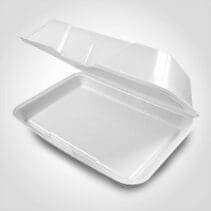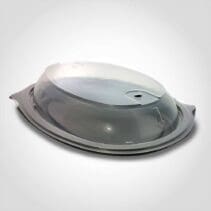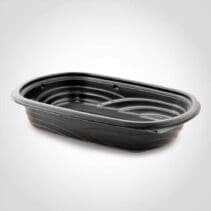SeeShell® 8″ Square PLA Medium Hinge
Dimensions: 8.5 x 8 x 2.84 in
The deep compostable clamshell has a unique blend of physical properties of NatureWorks® polymer makes it well suited for a broad range of packaging applications including high-value films, rigid thermoformed food and beverage containers, coated papers and boards and other packaging applications. Coupled with its unique environmental attributes, it is the only packaging material with significantly reduced greenhouse gas emissions to combine performance with environmental benefits.
Ingeo is made from dextrose (sugar) that is derived from field corn already grown for many industrial and functional end-uses. In North America, corn has been used first because it is the most economically ,feasible source of plant starches. Ingeo uses less than 1/20th of 1% (0.05%) of the annual global corn crop today, so there’s little to no impact on food prices or supply. The process does not require corn, Ingeo only needs a sugar source. This could include sugar beets, sugar cane, wheat and more.
Features and Benefits
-
- Made from Ingeo® biopolymer, a PLA resin derived entirely from plants
- Plant sources are domestically grown and annually renewable
- Crystal clear for total product visibility
- Durable material; no flavor or odor transfer
- Not suitable for microwave use
*BPI certified to be 100% compostable in actively managed municipal or industrial facilities, which may not be available in your area. Not suitable for backyard composting.
RENEWING INGEO: END-OF-LIFE OPTIONS
We at NatureWorks have carefully developed a vision for the disposal and recycling of products made with Ingeo. Yet when thinking about environmental impact, it’s important to recognize that true evironmental advantage starts at the beginning. By design, using Ingeo results in 75% less greenhouse gases than the oil-based PET plastic it replaces, even if both end up in a landfill. Read More
ECO-PROFILE
An eco-profile is a useful tool for fully determining Ingeo’s environmental impact. The profile adds up all of the inputs and outputs from our manufacturing process (like water to grow feedstocks, CO2 sequestered, energy to produce farming equipment, greenhouse gases emitted by our plant) from the field to factory gate…or from the corn being grown to boxes of Ingeo leaving our plant in Blair, NE. This calculation helps us determine Ingeo’s impact on several indicators including greenhouse gas emissions and non-renewable energy use.
may not be available in your area. Not suitable for backyard composting
HOW INGEO IS MADE
 |
INGEO BIOPOLYMER STARTS WITH PLANTS |
This revolutionary bioplastic is made up of long molecular chains of the polymer polylactide. It is derived from naturally-occurring plant sugar.
 |
 |
 |
Ingeo is made from dextrose (sugar) that is derived from field corn already grown for many industrial and functional end-uses. In North America, corn has been used first because it is the most economically feasible source of plant starches.
We use less than 1/25th of 1% (0.04%) of the annual global corn crop today, so there’s little to no impact on food prices or supply(1).
Our process does not require corn; we only need a sugar source. In the future this will include cellulosic raw materials, agricultural wastes and non-food plants.
 |
PHOTOSYNTHESIS: NATURE’S WAY OF MAKING SUGAR |
 |
Carbon Dioxide
from the air is absorbed by the leaves of a plant. |
 |
|
 |
Water
is taken in from the soil by the roots. |
 |
|
 |
Sunlight
provides the energy needed to transform carbon dioxide and water into glucose and oxygen – a process called photosynthesis. |
 |
|
|
Glucose (Sugar)
is made by the plant and used as fuel. Any unused sugar is stored as starch and can be harvested to use for making Ingeo biopolymer. |
 |
 |
|
|
Oxygen
is released back into the atmosphere.
|
 |
 |
TURNING SUGAR INTO POLYMER |
 |
Microorganismsconvert the sugar into lactic acid through fermentation. |
 |
|
 |
Dextrose (Sugar)is created from the harvested plant starch (made during photosynthesis) through a process called hydrolysis. |
 |
|
 |
Lactic Acid MoleculesA 2-step process transforms the lactic acid molecules into rings of lactide. |
 |
|
 |
Lactide Ringopens and linkes together to form a long chain of polylactide polymer. This is the process of polymerization. |
 |
|
Polymer Chain A chain of polymer can consist of tens of thousands of units linked together.
|
|
 |
|
 |
|
 |
Ingeo PelletsThe plastic is then formed into Ingeo pellets and is used by our partners to make a wide-range of products including food serviceware, fresh food packaging, consumer electronics, flexible films, cards, nonwovens, apparel and more. |
 |
INNOVATING WITH INGEO |
Once we’ve made our Ingeo biopolymer, our partners transform it into innovative products including food serviceware, fresh food packaging, electronics, flexible films, cards, nonwovens, apparel and home textiles. Since the Ingeo carbon footprint for Ingeo is 60%(2) lower than traditional materials like PS or PET, our partners are able to offer consumers a more responsible choice in buying everyday items.
 |
 |
 |
 |
 |
 |
 |
 |
 |
 |
 |
MORE END-OF-LIFE-OPTIONS |
Ingeo has more end-of-life options than any traditional plastic. Products made with Ingeo are compatible with existing recycling systems, can be cleanly incinerated, and are completely stable in landfill ‚¬Ã¢‚¬Å“ still the unfortunate fate for most of today’s plastics. When thinking about environmental impact, it’s important to recognize that true eco-advantage starts at the beginning. By design, using Ingeo results in 60% less greenhouse gases than the oil-based PET or PS plastic it replaces, even if both end up in a landfill.
 |
 |
 |
 |
 |
More importantly, using Ingeo creates two new opportunities to help achieve a zero-waste environment.
First, food serviceware products made from Ingeo plastic can be industrial composted ‚¬Ã¢‚¬Å“ a much needed solution when disposable utensils are contaminated with food remnants. This organics recovery is already successfully diverting food waste from landfill to compost. Check out case studies showing how Ingeo is helping teams across the United States and Europe reduce their environmental impact here.
Second, feedstock recovery is an innovative low-carbon method of materials recovery. Products made from Ingeo biopolymer can be easily converted back into lactic acid. This is both a useful industrial feedstock and the basic chemical used to create Ingeo biopolymer.










Reviews
There are no reviews yet.